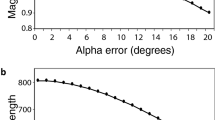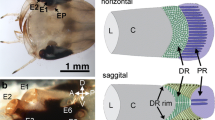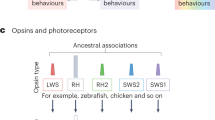Abstract
Dragonflies of the genus Sympetrum have compound eyes conspicuously divided into dorsal and ventral regions. Using anatomical, optical, electrophysiological, in-vivo photochemical and microspectrophotometrical methods, we have investigated the design and physiology of the dorsal part which is characterized by a pale yellow-orange screening pigment and extremely large facets. The upper part of the yellow dorsal region is a pronounced fovea with interommatidial angles approaching 0.3°, contrasting to the much larger values of 1.5°–2° in the rest of the eye. The dorsal eye part is exclusively sensitive to short wavelengths (below 520 nm). It contains predominantly blue-receptors with a sensitivity maximum at 420 nm, and a smaller amount of UV-receptors. The metarhodopsin of the blue-receptors absorbs maximally at 535 nm. The yellow screening pigment transmits longwavelength light (cut-on 580 nm), which increases the conversion rate from metarhodopsin to rhodopsin (see Fig. 11a). We demonstrate that because of the yellow pigment screen nearly all of the photopigment is in the rhodopsin state under natural conditions, thus maximizing sensitivity. Theoretical considerations show that the extremely long rhabdoms (1.1 mm) in the dorsal fovea are motivated for absorption reasons alone. A surprising consequence of the long rhabdoms is that the sensitivity gain, caused by pumping photopigment into the rhodopsin state, is small. To explain this puzzling fact we present arguments for a mechanism producing a gradient of rhodopsin concentration along the rhabdom, which would minimize saturation of transduction units, and hence improve the signal-to-noise ratio at high intensities. The latter is of special importance for the short integration time and high contrast sensitivity these animals need for spotting small prey at long distances.
Similar content being viewed by others
Abbreviations
- ERG :
-
electroretinogram
- R :
-
rhodopsin
- M :
-
metarhodopsin
References
Armett-Kibel C, Meinertzhagen IA (1983) Structural organization of the ommatidium in the ventral compound eye of the dragonfly Sympetrum. J Comp Physiol 151: 285–295
Barlow RB, Birge RR, Kaplan E, Tallent JR (1993) On the molecular origin of photoreceptor noise. Nature 366: 64–66
Bernard GD (1983) Bleaching of rhabdoms in eyes of intact butterflies. Science 219: 69–71
Bertrand D, Fuortes G, Muri R (1979) Pigment transformation and electrical responses in retinula cells of drone, Apis mellifera. J Physiol (Lond) 296: 431–441
Bruno MS, Barnes SN, Goldsmith TH (1977) The visual pigment and visual cycle of the lobster Homarus. J Comp Physiol 120: 123–142
Burkhardt D, Streck P (1965) Das Sehfeld einzelner Sehzellen: Eine Richtigstellung. Z Vergl Physiol 51: 151–152
Demoll R (1913) Gelegentliche Beobachtungen an Libellen. Biol Zentralbl 33: 727–733
Dubs A, Laughlin SB, Srinivasan MV (1981) Single photon signals in fly photoreceptors and first order interneurones at behavioural threshold. J Physiol (Lond) 317: 317–334
Ebrey TG, Honig B (1977) New wavelength dependent visual pigment nomograms. Vision Res 17: 147–151
Franceschini N, Kirschfeld K (1971) Les phénomènes de pseudopupille dans l'œil composé de Drosophila. Kybernetik 9: 159–182
Gates DM (1980) Biophysical ecology, Springer, New York Heidelberg Berlin
Gogala M (1967) Die spektrale Empfindlichkeit der Doppelaugen von Ascalaphus macaronius Scop. (Neuroptera, Ascalaphidae). Z Vergl Physiol 57: 232–243
Gogala M, Hamdorf K, Schwemer J (1970) UV-Sehfarbstoff bei Insekten. Z Vergl Physiol 70: 410–413
Hamdorf K (1979) The physiology of invertebrate visual pigments. In: Autrum H (ed) Handbook of sensory physiology, vol VII/6A. Springer, Berlin Heidelberg New York, pp 145–224
Hamdorf K, Gogala M, Schwemer J (1971) Beschleunigung der “Dunkeladaptation” eines UV-Rezeptors durch sichtbare Strahlung. Z Vergl Physiol 75: 189–199
Hamdorf K, Paulsen R, Schwemer J (1973) Photoregeneration and sensitivity control of photoreceptors of invertebrates. In: Langer H (ed) Biochemistry and physiology of visual pigments. Springer, Berlin Heidelberg New York, pp 156–166
Hateren JH van (1984) Waveguide theory applied to optically measured angular sensitivities of fly photoreceptors. J Comp Physiol A 154: 761–771
Henderson ST, Hodgkiss D (1963) The spectral energy distribution of daylight. Br J Appl Phys 14: 125–131
Hochstrate P, Hamdorf K (1990) Microvillar components of light adaptation. J Gen Physiol 95: 891–910
Horridge GA (1969) Unit studies on the retina of dragonflies. Z Vergl Physiol 62: 1–37
Horridge GA (1976) The ommatidium of the dorsal eye of Cloëon as a specialization for photoreisomerization. Proc R Soc Lond B 193: 17–29
Horridge GA, McLean M (1978) The dorsal eye of the mayfly Ataloplebia (Ephemeroptera). Proc R Soc Lond B 200: 137–150
Horridge GA, Marcelja L, Jahnke R (1982) Light guides in the dorsal eye of the male mayfly. Proc R Soc Lond B 216: 25–51
Howard J, Snyder AW (1983) Transduction as a limitation on compound eye function and design. Proc R Soc Lond B 217: 287–307
Howard J, Blakeslee B, Laughlin SB (1987) The intracellular pupil mechanism and photoreceptor signal: noise ratios in the fly Lucilia cuprina. Proc R Soc Lond B 231: 415–435
Kirschfeld K (1974) The absolute sensitivity of lens and compound eyes. Z Naturforsch 29c: 592–596
Kirschfeld K, Wenk P (1976) The dorsal compound eye of simuliid flies: An eye specialized for the detection of small, rapidly moving objects. Z Naturforsch 31: 764–765
Land MF (1981) Optics and vision in invertebrates. In: Autrum H (ed) Handbook of sensory physiology, vol VII/6B. Springer, Berlin Heidelberg New York, pp 471–592
Land MF (1989) Variations in the structure and design of compound eyes. In: Stavenga DG, Hardie RC (eds) Facets of vision. Springer, Berlin Heidelberg, pp 90–111
Laughlin SB (1989) The reliability of single neurons and circuit design: a case study. In: Durbin R, Miall C, Mitchison G (eds) The computing neuron. Addison Wesley, Wokingham, pp 322 -336
Laughlin SB, McGinnes S (1978) The structure of dorsal and ventral regions of a dragonfly retina. Cell Tissue Res 188: 427–447
Laughlin SB, Howard J, Blakeslee B (1987) Synaptic limitations to contrast coding in the retina of the blowfly Calliphora. Proc R Soc Lond B 231:437–467
Mayer G (1961) Studien an der Heidelibelle Sympetrum vulgatum (L.). Naturk Jb Linz 7: 201–217
Mazokin-Porshniakov GA (1959) Colorimetric study of vision in the dragonfly. Biofizika 4: 427–436
McFarland WN, Munz FW (1974) The visible spectrum during twilight and its implications to vision. In: Evans GC, Bainbridge R, Rackham O (eds) Light as an ethological factor: II. The 16th symposium of the British Ecological Society 1974. Blackwell Scientific Publications, Oxford London Edinburgh Melbourne, pp 249–287
Meinertzhagen IA, Menzel R, Kahle G (1983) The identification of spectral receptor types in the retina and lamina of the dragonfly Sympetrum rubicundulum. J Comp Physiol 151: 295–310
Menzel J, Wunderer H, Stavenga DG (1991) Functional morphology of the divided compound eye of the honeybee drone (Apis mellifera). Tissue Cell 23: 525–535
Meyer EP, Labhart T (1993) Morphological specializations of dorsal rim ommatidia in the compound eye of dragonflies and damselflies (Odonata). Cell Tissue Res 272: 17–22
Nilsson D-E, Howard J (1989) Intensity and polarization of the eyeshine in butterflies. J Comp Physiol A 166: 51–56
Nilsson D-E, Modlin RF (1994) A mysid shrimp carrying a pair of binoculars. J Exp Biol 189: 213–236
Ruck P (1958) A comparison of the electrical responses of compound eyes and dorsal ocelli in four insect species. J Insect Physiol 2: 261–274
Ruck P (1965) The components of the visual system of a dragonfly. J Gen Physiol 49: 289–307
Schneider L, Gogala M, Draslar K, Langer H, Schlecht P (1978) Feinstruktur und Schirmpigment-Eigenschaften der Ommatidien des Doppelauges von Ascalaphus (Insecta, Neuroptera). Eur J Cell Biol16: 274–307
Schwemer J (1993) Visual pigment renewal and the cycle of chromophore in the compound eye of the blowfly. In: Wiese K et al. (eds) Sensory systems in arthropods. Birkhäuser, Basel, pp 54–68
Snyder AW (1977) Acuity of compound eyes: Physical limitations and design. J Comp Physiol 116: 161–182
Snyder AW (1979) The physics of vision in compound eyes. In: Autrum H (ed) Handbook of sensory physiology, vol VII/6A. Springer, Berlin Heidelberg New York, pp 225–313
Stavenga DG (1979) Pseudopupils of compound eyes. In: Autrum H (ed) Handbook of sensory physiology, vol VII/6A. Springer, Berlin Heidelberg New York, pp 357–439
Stavenga DG (1989) Pigments in compound eyes. In: Stavenga DG, Hardie RC (eds) Facets of vision. Springer, Berlin Heidelberg, pp 153–172
Stavenga DG (1992) Eye regionalization and spectral tuning of retinal pigments in insects. Trends Neurosci 15: 213–218
Stavenga DG (1993) Screening pigments and photoconversion in the fly eye. In: Wiese K, Gribakin FG, Popov AV, Renninger G (eds) Sensory systems of arthropods. Birkhäuser, Basel, pp 81–90
Stavenga DG, Schwemer J (1984) Visual pigments of invertebrates. In: Ali MA (ed) Photoreception and vision in invertebrates. Plenum, New York, pp 11–61
Stavenga DG, Smits RP, Hoenders BJ (1993) Simple exponential functions describing the absorbance band of visual pigment spectra. Vision Res 33: 1011–1017
Streck P (1972) Der Einfluß des Schirmpigmentes auf das Sehfeld einzelner Sehzellen der Fliege Calliphora erythrocephalia Meig. Z Vergl Physiol 76: 372–402
Vallet AM, Coles JA (1991) A method for estimating the minimum visual stimulus that evokes a behavioural response in the drone, Apis mellifera. Vision Res 31: 1453–1455
Warrant EJ, Pinter RB (1990) Changes of acuity during light and dark adaptation in the dragonfly compound eye. Z Naturforsch 45c: 137–141
Wehner R (1981) Spatial vision in arthropods. In: Autrum H (ed) Handbook of sensory physiology, vol VII/6A. Springer, Berlin Heidelberg New York, pp 287–616
Author information
Authors and Affiliations
Rights and permissions
About this article
Cite this article
Labhart, T., Nilsson, DE. The dorsal eye of the dragonfly Sympetrum: specializations for prey detection against the blue sky. J Comp Physiol A 176, 437–453 (1995). https://doi.org/10.1007/BF00196410
Accepted:
Issue Date:
DOI: https://doi.org/10.1007/BF00196410




